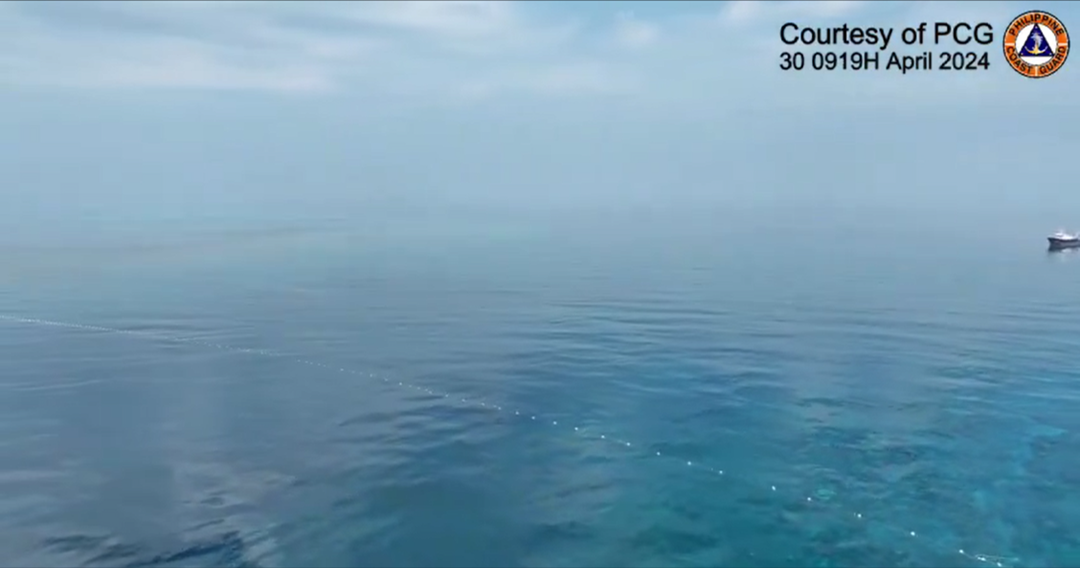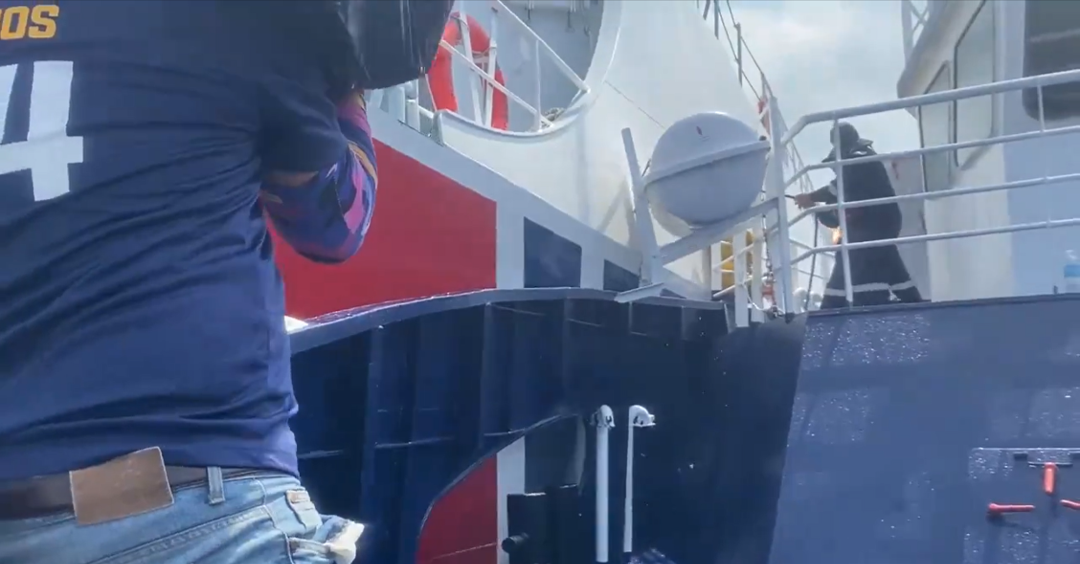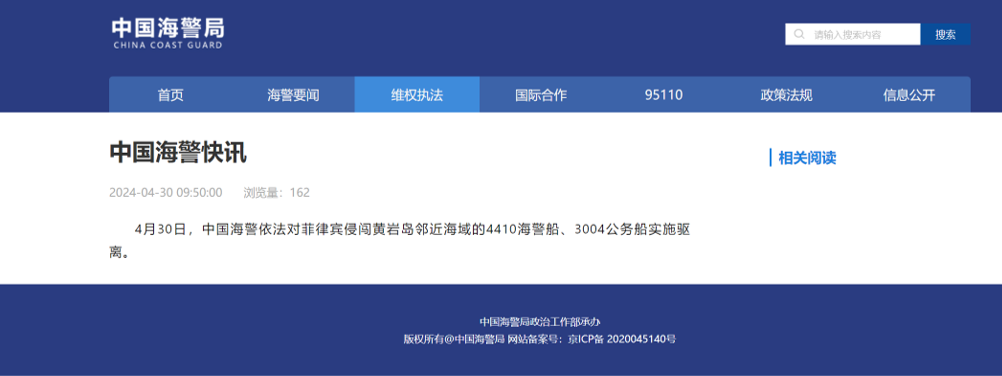On April 30th, several China Coast Guard (CCG) and China Maritime Militia (CMM) vessels intercepted one Philippine Coast Guard (PCG) ship and one Bureau of Fisheries and Aquatic Resources (BFAR) vessel during their patrol near Scarborough Shoal (Bajo De Masinloc). The Philippine vessels’ mission was to distribute food and fuel to the Philippine fishermen operating in and around the shoal. However, as the vessels neared the shoal, at least four CCG ships and six CMM vessels began to harass the BRP Bacagay and BRP Datu Bankaw.
Incident
At 09:32 a.m. local time, two CCG vessels blocked the Bacagay’s path when it was around 1000 yards (914 m) east-southeast of Scarborough Shoal. The Chinese vessels then began to spray the Bacagay with “jet stream water cannons” from both sides, which damaged the ship’s railing and canopy. However, the Bacagay successfully reached the mouth of Scarborough Shoal but could not enter the shoal due to CCG installing a 328-yard (380-meter) floating barrier across the shoal’s mouth before the incident.

Another CCG vessel moved along side and began to spray the Datu Bankaw with its water cannons at around 9:53 a.m. local time, when the vessel was approximately 12 nautical miles (22 km) from the shoal. The vessel also attempted to ram the BFAR’s hull, but two crewmembers placed yellow barriers that prevented any additional damage from occurring. The CCG vessels sprayed the BFAR vessel eight times with their water cannons, while both CCG and CMM ships rammed the Datu Bankaw three times during the incident. The BFAR vessel received some damage to its HVAC, electric, navigation, and radio systems, as well as some “superficial damage” to its hull. However, the Bacagay successfully reached the mouth of Scarborough Shoal despite the CCG and CMM’s harassment of the vessel.

However, the PCG’s Spokesperson for the South China Sea, Commodore Jay Tarriela, said that the BFAR and PCG vessels continued their maritime patrol and resupplied the fishermen despite the “harassment and proactive actions” of the CCG and CMM.
China’s Reaction
The CCG released two statements on both its website and Chinese social media accounts about the incident that occurred between the Philippine and Chinese vessels at Scarborough Shoal. The coast guard released the first statement at 9:50 a.m. local time that stated the CCG “drove away” the PCG and BFAR vessels that intruded into the waters near Huangyan Island (Scarborough Shoal).

The CCG’s spokesperson, Gan Yu, released a second statement that contained more information about the incident. Gan said that the Philippine vessels “ignored China’s repeated dissuasions and warnings and insisted on sailing and invading” the waters near Scarborough Shoal. The CCG took the necessary measures in accordance with the law, such as “follow-up, water cannon warnings, and blockade control,” to drive away the “illegally intruding Philippine ships.” Gan described the CCG’s operations as “professional, standardized, legitimate, and lawful,” and the Philippines’ actions infringed on China’s “sovereignty and seriously violated international law and the basic norms of international relations.”
Gan said China urges the Philippines to immediately stop its infringement of its territory and that the country has “indisputable sovereignty over Huangyan Island [Scarborough Shoal] and its adjacent waters and has sovereign rights and jurisdiction over relevant waters.” The spokesperson stated that the CCG will continue to conduct law enforcement and rights protection activities in waters under China’s jurisdiction according to Chinese law. The CCG will also “resolutely safeguard national territorial sovereignty and maritime rights and interests.”
China’s Foreign Affairs Ministry (FAM) also released a statement about the incident at Scarborough Shoal during its daily press conference on April 30th. The statement came in the form of a response to a question from a Reuters reporter about the incident. The question was, “the Chinese Coast Guard said it expelled Philippine Coast Guard ships and vessels that intruded into waters near the Scarborough Shoal. Does the Foreign Ministry have any comment?”
The FAM spokesperson, Lin Jian, answered the question first by saying that Huangyan Dao [Scarborough Shoal] “has always been China’s territory.” The PCG vessel and BFAR vessel entered the waters of Scarborough Shoal without Chinese permission, which “seriously infringed on China’s sovereignty.” Jin said that the CCG “took necessary measures to expel them in accordance with the law.” He said that the country “urges the Philippines to stop making infringements and provocations at once and not to challenge China’s resolve to defend our sovereignty.”
Analysis
China likely conducted the incident at Scarborough Shoal to show its displeasure for the upcoming Atin Ito! convoy to the Scarborough Shoal while also using the incident to further push its narrative that the United States is provoking instability in the SCS. The incident also indicates that China will extend its aggressive tactics, such as water cannons and ramming, to the Scarborough Shoal and other features in the SCS.
The country conducted the incident to show its displeasure at the upcoming Atin Ito! mission to the Scarborough Shoal in May. The mission will consist of a convoy of approximately 100 vessels that will sail to the shoal to place buoys marked with ‘WPS, Atin Ito!’ to support the Philippines’ claim to the shoal. China likely viewed the mission as crossing a red line, which the country wanted to prevent by showing the Philippines that it would protect its sovereignty through the use of water cannon blasts and ramming. Furthermore, the barrier placed at the shoal’s mouth reinforces this argument since the convoy would likely install the buoys while handing out supplies when they were inside the lagoon. However, China will likely maintain the floating barrier at the shoal until Atin Ito heavily modifies its mission or the Philippines denies its request.
The narrative that China uses the incident to push is that the Philippines is being urged by the United States into provoking China in the SCS. China used state-owned news outlets such as the Global Times (GT) and CGTN to spread this narrative through the various news articles and social media posts. For example, GT published a cartoon showing Philippine President Ferdinand Marcos Jr. stirring the SCS with a stick while an Uncle Sam-shaped shadow stood behind him, urging him on. China wanted to show that the Marcos administration is only “stirring up trouble” because the United States is provoking them as a “black hand behind the scenes.” Furthermore, the cartoon also shows that Marcos is a willing ‘stooge’ for the United States, which is a talking point that several anti-U.S. Philippine groups use to protest the United States’ presence and exercises such as Balikatan.
However, the use of aggressive tactics such as water cannons and ramming indicates that China wants to damage enough vessels to force the Philippines to decrease the number of patrols it conducts at Scarborough Shoal. China likely understands that the Philippines currently lacks the necessary support infrastructure to simultaneously repair multiple PCG and BFAR vessels damaged during the patrols. China believes that it could overburden the infrastructure by damaging the vessels both the PCG and BFAR use to conduct the patrol missions. Furthermore, the damage to key systems such as navigation and communications systems will also increase the cost that the Philippines must sustain to repair the vessels and make them seaworthy again. The increased costs will force the Philippines to increase funds to repair the vessels by shifting funds from other parts of the government budget. The Philippines would eventually be forced to choose between supporting its military modernization program or repairing the vessels damaged by the CCG and CMM.

